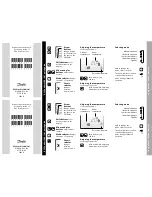
3
Position Light Signals (common cathode wiring; e.g. Oregon Rail Supply)
Wiring for position light signals is shown in Figure 2 using the Eastbound signal outputs; the connections are similar for the
Westbound signal outputs. For common cathode LED signals you MUST use current limiting resistors! Within the signal
head are six or seven LEDs; if you have a B&O style color position light signal then it will not have a center LED and you
will not use the CTR terminal on the
Block Animator/2
.
If you are using the Oregon Rail Supply brand of signals it is
NOT necessary to purchase their diode logic board; the
Block Animator/2
contains all of the necessary circuitry to
properly control these signals.
Although we include 150 ohm current limiting resistors with the
Block Animator/2
you
might find the signal lights too dim. If so, we recommend changing to a value of 100 ohms (e.g. g
www.mouser.com
part
number 291-100-RC).
NOTE: if you have an Integrated Signal Systems position light signal you might need to lower
the resistor to a value of 68 ohms. This is due to the fact that these signals have the LEDs wired in SERIES and thus a
larger voltage is required to turn on the signal.
Common (-)
Clear position
Stop position
Approach position
Center LED/bulb
Current limiting resistors
(see text)
Figure 2 – Position light signal
If your signal is an “absolute” type (that means it has two red LEDs/bulbs for the stop
position while all others are yellow) then you will have to cut the wire jumper labeled JP8
for the Eastbound signal shown in Figure 3 on the
Block Animator/2
board (jumper JP7 is
for the Westbound signal). Use a pair of diagonal cutters to make the cut. Be sure that the
two cut ends no longer touch each other by separating them slightly. Failure to do so won’t
cause any damage but it may cause the center yellow LED/bulb to illuminate when the
signal is in the stop position.
Figure 3
Sensor modes
The
Block Animator/2
supports four different sensor (detector) modes: photocell, between-the-rails infrared, across-the-rails
infrared, and external detector. When you purchased this product it either came with a photocell, infrared components or
neither (board only, for use with external detectors). The sensor mode is selected using the switches labeled SEN TYPE and
SEN POL as depicted in the Table 1 below.
Photocell
SEN TYPE – OFF
SEN POL - OFF
Between-the-rails Infrared
SEN TYPE – ON
SEN POL - ON
Across-the-rails Infrared
SEN TYPE – ON
SEN POL - OFF
External Detector
SEN TYPE – OFF
SEN POL - ON
Table 1 – Sensor mode selection


























